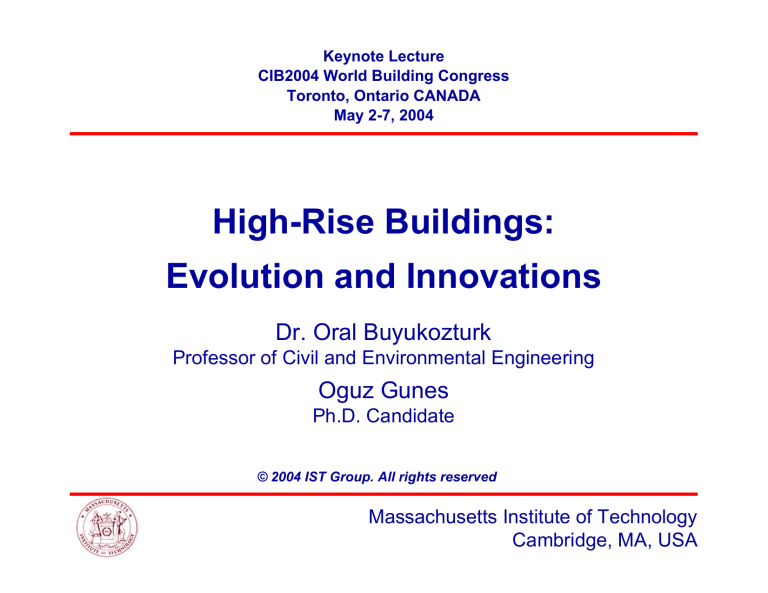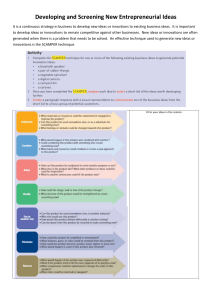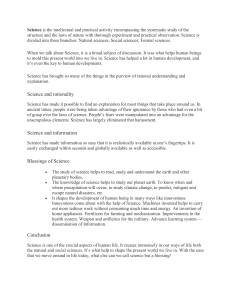
Keynote Lecture CIB2004 World Building Congress Toronto, Ontario CANADA May 2-7, 2004 High-Rise Buildings: Evolution and Innovations Dr. Oral Buyukozturk Professor of Civil and Environmental Engineering Oguz Gunes Ph.D. Candidate © 2004 IST Group. All rights reserved Massachusetts Institute of Technology Cambridge, MA, USA OUTLINE • INTRODUCTION • LOADS • EVOLUTION • INNOVATIONS • CONCLUSION © 2004 IST Group Introduction Introduction Loads Loads Evolution Evolution Innovations Innovations Conclusion Conclusion Introduction What is a high-rise building? “A building whose height creates different conditions in the design, construction, and use than those that exist in common buildings of a certain region and period.” The Council of Tall Buildings and Urban Habitat © 2004 IST Group Introduction Introduction Introduction Introduction Loads Loads Evolution Evolution Innovations Innovations Conclusion Conclusion Demand for High-Rise Buildings • Scarcity of land in urban areas • Increasing demand for business and residential space • Economic growth • Technological advancements • Innovations in Structural Systems • Desire for aesthetics in urban settings • Concept of city skyline • Cultural significance and prestige • Human aspiration to build higher © 2004 IST Group Introduction Introduction Introduction Introduction Loads Loads Evolution Evolution Innovations Innovations Conclusion Conclusion Geographical Distribution of High-Rise Buildings (Tables source: Emporis Corporation April 2004) © 2004 IST Group Introduction Introduction Introduction Introduction Loads Loads Evolution Evolution Innovations Innovations Conclusion Conclusion Economy vs. Demand for High-Rise Buildings Economic growth and resulting demand for office space is a good indication of demand for high-rise buildings U.S. Asking Office Rents, Class A U.S. Gross Domestic Product 10% 8% 6% 4% 2% 0% -2% 2001 $ Per Sq. Ft. Per Year Full Service CBD Suburban $50 $40 $30 2002 2003 2004 $20 Jan-98Jan-99Jan-00Jan-01Jan-02Jan-03Jan-04 U.S. Office Supply vs. Demand Sq. Ft. in Millions U.S. Office Vacancy Rates Completed Absorbed 150 100 50 0 -50 -100 19.0% 17.0% 15.0% 13.0% 11.0% 9.0% 7.0% 5.0% 86 88 90 92 94 96 98 00 86 88 90 92 94 96 98 00 02 04 02 04 (Grubb & Ellis Company, 2004) © 2004 IST Group Introduction Introduction Introduction Introduction Loads Loads Evolution Evolution Innovations Innovations Conclusion Conclusion Structural Loads Snow Load • Gravity loads – Dead loads – Live loads – Snow loads Impact Load Dead Loads • Lateral loads – Wind loads – Seismic loads Wind Load Live Loads • Special load cases – Impact loads – Blast loads Blast Load Earthquake Load © 2004 IST Group Introduction Introduction Loads Loads Loads Loads Evolution Evolution Innovations Innovations Conclusion Conclusion Gravity Loads • • • Floor systems account for a major portion of the gravity loads Selection of the floor system may influence structural behavior and resistance Structural use plays a major role in selection of the floor system – Office buildings • large simply supported spans – Residential and hotel buildings • short continuous spans Types of floor systems • Concrete • Prestressed concrete • Steel • Composite © 2004 IST Group Introduction Introduction Loads Loads Loads Loads Evolution Evolution Innovations Innovations Conclusion Conclusion Wind Loads Qh Qz Qh Qh Qz Plan view z H Qh Wind ch (S 7) 97 1 r, lle e u Qz = KV I 2 Qh = Qz z=H (Taranath, 1998) © 2004 IST Group Introduction Introduction Loads Loads Loads Loads Evolution Evolution Innovations Innovations Conclusion Conclusion Seismic Loads Spectral response acceleration (g) Response with increasing damping W 0 V 2 4 6 8 Period (sec) V = Cs × W Decreasing V/W © 2004 IST Group Introduction Introduction Loads Loads Loads Loads Evolution Evolution Innovations Innovations Conclusion Conclusion Design for Increased Height • Building weight and cost increase nonlinearly with increasing height due to lateral loads • Efficient structural and material systems are needed to reduce weight and cost • Wind loads generally govern design for lateral loads for heights • > 150 m for steel buildings • > 250 m for concrete buildings (Ali, M., 2001) © 2004 IST Group Introduction Introduction Loads Loads Loads Loads Evolution Evolution Innovations Innovations Conclusion Conclusion Evolution of Structural Systems A clear classification of high-rise buildings with respect to their structural system is difficult A rough classification can be made with respect to effectiveness in resisting lateral loads Structural Systems • • • • Moment resisting frame systems Braced frame, shear wall systems Core and outrigger systems Tubular systems – Framed tubes – Trussed tubes – Bundled tubes • Hybrid systems © 2004 IST Group Introduction Introduction Loads Loads Evolution Evolution Evolution Evolution Innovations Innovations Conclusion Conclusion Evolution of Structural Systems • • • • • • • • • • • • • • • • • • • • • • • • • • • • • • • • • • • Type I Introduction Introduction • • • • • • • • • • • • • • • • • • • • • • • • • • • • • • • • • • • • • • • • • • • • • • • • • Type II Loads Loads •• • •• • •• • • • • • • • • • • • • • • • • • • •• Type III Evolution Evolution Evolution Evolution •• • •• • • •• •• •• •• •• •• •• • •• • • Type IV Innovations Innovations Exterior Diagonalized Tube • • • • • • • • • • • • • • • • • • • • • • • • • • • • • • • • • • 10 Bundled Framed Tube 20 •• •• •• •• • •• • •• Semi-Rigid Frame 30 Rigid Frame 40 •• • •• • •• •• •• •• 50 Exterior Framed Tube Frame with Shear Truss 60 • • •• • •• (CTBUH, 1980) •• • •• • •• 70 90 Shear Frames Interacting Systems Partial Tubular Systems Tubular Systems End Channel and Middle I Framed Tubes 80 Type I Type II Type III Type IV End Channel Framed Tube with Interior Shear Trusses 100 # of Floors Frame with Shear band and Outrigger Trusses 110 • • • • • • •• © 2004 IST Group Conclusion Conclusion Shear Frame System • • • • Resists lateral deformation by joint rotation Requires high bending stiffness of columns and beams Rigid joints are essential for stability Not effective for heights over 30 stories © 2004 IST Group Introduction Introduction Loads Loads Evolution Evolution Evolution Evolution Innovations Innovations Conclusion Conclusion Braced Frame System • • • Lateral forces are resisted by axial actions of bracing and columns Steel bracing members or filled-in bays More efficient than a rigid frame Cantilever Shear Combined © 2004 IST Group Introduction Introduction Loads Loads Evolution Evolution Evolution Evolution Innovations Innovations Conclusion Conclusion Core Structure System • • • • Lateral and gravity loads supported by central core Eliminates columns and bracing elements Core is inefficient because it is not deep in respect to bending Moment supported floors are inefficient Individually cantilevered floors Cantilever supports Group cantilevered floors Core © 2004 IST Group Introduction Introduction Loads Loads Evolution Evolution Evolution Evolution Innovations Innovations Conclusion Conclusion Outrigger Braced Structure System • • • 1- or 2-story deep truss connects core to perimeter columns Outriggers Increases the bending rigidity Dependent of rigid core for shear resistance Braced core Tension Compression © 2004 IST Group Introduction Introduction Loads Loads Evolution Evolution Evolution Evolution Innovations Innovations Conclusion Conclusion Tubular System • • • • • Majority of structural elements around the perimeter Sides normal to lateral load resist bending Sides parallel to lateral load resist shear Minimize number of interior columns Closely spaced exterior columns Increased stress at corners created by shear lag effect Closely spaced columns © 2004 IST Group Introduction Introduction Loads Loads Evolution Evolution Evolution Evolution Innovations Innovations Conclusion Conclusion Hybrid Systems • Combine advantages of different structural and material systems • Composite material system • Concrete super columns • Steel encased concrete columns • Composite floor system • Steel truss and outrigger systems • High strength concrete super columns reduce deflections and weight • Steel encased HS concrete combines • easy erectability of steel, • axial load capacity of HS concrete, • efficient confinement and reinforcement. © 2004 IST Group Introduction Introduction Loads Loads Evolution Evolution Evolution Evolution Innovations Innovations Conclusion Conclusion High-Efficiency Mega-Braced Frame System Mega braces • • • • Very large columns and bracing Small number of columns Bracing extends over multiple floors Stiff transfer floors allow for internal flexiblity Transfer zones Mega columns © 2004 IST Group Introduction Introduction Loads Loads Evolution Evolution Evolution Evolution Innovations Innovations Conclusion Conclusion Evolution of Materials • High performance concrete (HPC) • High performance steel (HPS) • Composite construction Composite 33% Steel 42% Concrete 25% Number of Buildings Material systems of the tallest 200 Buildings 20 18 16 14 12 10 8 6 4 2 0 1930 1940 1950 1960 1970 1980 1990 2000* Decade © 2004 IST Group Introduction Introduction Loads Loads Evolution Evolution Evolution Evolution Innovations Innovations Conclusion Conclusion Innovations • Vulnerability and risk assessment • Performance based design • Materials • Structural control • Egress strategies © 2004 IST Group Introduction Introduction Loads Loads Evolution Evolution Innovations Innovations Innovations Innovations Conclusion Conclusion Vulnerability and Risk Assessment • Probabilistic risk assessment (PRA) and decision making have been effectively used in • nuclear engineering, • manufacturing, • seismic loss estimation etc. • Probabilistic, nonlinear, and coupled evaluation of building vulnerability is needed for identified hazards. Hazard identification, prioritization and evaluation Risk assessment & Loss estimation Vulnerability analysis Decision & Implementation Optimum mitigation strategy © 2004 IST Group Introduction Introduction Loads Loads Evolution Evolution Innovations Innovations Innovations Innovations Conclusion Conclusion Risk Assessment and Performance Based Design Hazard Analysis Amplification Seismic source ation Attenu SPECTRAL ACCELERATION Vulnerability Analysis STRONGER CONSTRUCTION WEAKER CONSTRUCTION MINOR SHAKING MAJOR SHAKING MODERATE SHAKING SPECTRAL DISPLACEMENT Structural model NONE Introduction Introduction Loads Loads SLIGHT Evolution Evolution MODERATE EXTENSIVE COLLAPSE Innovations Innovations Innovations Innovations © 2004 IST Group Conclusion Conclusion Design for Fire • Old: Prescriptive-Based Design – Design based on fire rating of materials used – Fire rating of material from tables – Compliance with a code specified value • New: Performance-Based Design – Evaluate the strength and stiffness for a particular design fire – Coupled stress-thermal analysis – Specialized design for fire effects – Use of fire retardant materials, advanced coatings and ceramics © 2004 IST Group Introduction Introduction Loads Loads Evolution Evolution Innovations Innovations Innovations Innovations Conclusion Conclusion Performance Evaluation Under Fire Coupled structural/fire analysis Structural Model Geometry Elastic/strength properties Thermal properties Onset of fire Time: 20 min Demand Structural loads Fire modeling Time: 35 min Thermal analysis Stress analysis Time: 45 min Weakest link Deformations, damage, collapse © 2004 IST Group Introduction Introduction Loads Loads Evolution Evolution Innovations Innovations Innovations Innovations Conclusion Conclusion Design for Impact Loading Engineering problems related to impact loads: • • • • • Modeling of impact Assessment of impact damage Evaluation of structural safety after impact Modeling of potential fire after impact Coupled evaluation of structural integrity and collapse potential (FEMA 403) © 2004 IST Group Introduction Introduction Loads Loads Evolution Evolution Innovations Innovations Innovations Innovations Conclusion Conclusion Impact Modeling Floor Core area V V Boeing 767-200 Floor Boeing 767-200 Exterior columns Core columns Boeing 767-200 Max. takeoff weight: 395,000 lb (180 ton) Max. fuel capacity: 24,000 gal (91,000 liter) Cruise speed: 530 mph (237 m/s) Total kinetic energy Velocity V ≈ 220 m/s Fuselage cutting force Ek = 12 MV 2 = 3460 MJ Pcutting ≈ 3.0 MN MIT Impact and Crashworthiness Laboratory © 2004 IST Group Introduction Introduction Loads Loads Evolution Evolution Innovations Innovations Innovations Innovations Conclusion Conclusion Energy Dissipation During Impact The initial kinetic energy of the plane is dissipated through • Permanent plastic deformation (crushing) Estimated distribution of energy dissipation • Generated Heat • Fracture and fragmentation Core columns 28% (creating new surfaces) • Friction • Residual velocity • Elastic vibrations Floor structure 53% May be used as a design tool Exterior columns 3% Aircraft 25% MIT Impact and Crashworthiness Laboratory © 2004 IST Group Introduction Introduction Loads Loads Evolution Evolution Innovations Innovations Innovations Innovations Conclusion Conclusion Design for Blast Loading Sequence of damage due to a blast outside the building Incident pressure waveform (FEMA 427) © 2004 IST Group Introduction Introduction Loads Loads Evolution Evolution Innovations Innovations Innovations Innovations Conclusion Conclusion Redundancy and Progressive Failure REDUNDANCY: Presence of alternate load paths PROGRESSIVE FAILURE: Successive failure of critical elements • Redundancy is essential for structural safety and protection • Ductile structural elements and details • Design for load reversals • Avoid shear failures Structural behavior Low redundancy High redundancy © 2004 IST Group Introduction Introduction Loads Loads Evolution Evolution Innovations Innovations Innovations Innovations Conclusion Conclusion Redundancy and Progressive Failure Redundancy in column system System Redundancy (Global frame) FEMA 403 Local Redundancy (Local joints) Redundancy in floor system Improved local redundancy © 2004 IST Group Introduction Introduction Loads Loads Evolution Evolution Innovations Innovations Innovations Innovations Conclusion Conclusion Design Against Progressive Failure © 2004 IST Group Introduction Introduction Loads Loads Evolution Evolution Innovations Innovations Conclusion Conclusion Materials Development • High performance concrete and steel enable efficient and innovative design • FRP composites may be effective in combination with conventional materials Relative MOE or Comp. Strength • Fiber reinforced concrete shows promise in fire protection Effect of Heat on Reinforced Concrete (2 hours of exposure to 1000 C fire) 1 Compressive Strength 0.8 0.6 0.4 Modulus of Elasticity 0.2 0 0 200 400 600 800 Temperature (C) 1000 Ordinary RC Riber RC © 2004 IST Group Introduction Introduction Loads Loads Evolution Evolution Innovations Innovations Innovations Innovations Conclusion Conclusion Structural Control • • Lateral motion problems can be resolved through various types of damping systems Controls systems can be implemented in initial design or as a retrofit Passive dampers are commonly used in new tall buildings • Viscous Dampers – Piston forcing fluid through an orifice – Compact and easily installed • Hysteretic Dampers – Dissipates energy by cyclic yielding in tensions and compression – Easy to install, but may need to be replaced after major event • Tuned Mass Dampers (TMD) – Translation TMD – Pendulum TMD © 2004 IST Group Introduction Introduction Loads Loads Evolution Evolution Innovations Innovations Innovations Innovations Conclusion Conclusion Structural Control Systems Diagonal brace with viscous or viscoelastic damper Chevron brace with viscous dampers Chevron brace with viscoelastic damper Pall friction damper Tuned liquid column damper damper spring actuator Tuned mass damper Active mass damper Tuned liquid damper Hybrid mass damper © 2004 IST Group Introduction Introduction Loads Loads Evolution Evolution Innovations Innovations Innovations Innovations Conclusion Conclusion Passive Structural Control John Hancock Building, Boston Tuned Mass Dampers cd p kd md u + ud u m c k Governing equations of motion: Building p (1+ m)u + 2ξωu + ω u = − mud m 2 Damper md m= m ud + 2ξdωd ud + ωd2ud = −u ki ω = mi 2 i ci = 2ξiωi mi © 2004 IST Group Introduction Introduction Loads Loads Evolution Evolution Innovations Innovations Innovations Innovations Conclusion Conclusion Active Structural Control Hybrid Mass Dampers cd p kd u + ud Nishikicho Building, Tokyo (Connor, 2003) u +ud + ua u m c k Governing equation of motion for the AMD u +ud + ua ka F ua + ωa2ua = −(u + ud ) + ma F ma © 2004 IST Group Introduction Introduction Loads Loads Evolution Evolution Innovations Innovations Innovations Innovations Conclusion Conclusion Health Monitoring Vibration techniques can be used to determine the vibration characteristics of high-rise buildings Advantages • Rapid • Can be used for periodic or continuous monitoring • Economically feasible • Provides a preliminary assessment of the building stiffness • Leads to more accurate seismic demand prediction Accelerometer(s) Data acquisition unit Ambient vibrations © 2004 IST Group Introduction Introduction Loads Loads Evolution Evolution Innovations Innovations Innovations Innovations Conclusion Conclusion Emergency Egress Strategies • Elevated passages to neighboring buildings • Refuge floors/rooms with fire escape elevators • Perimeter wall rescue vehicles • Fire resistant escape chutes • Flying rescue platforms • Individual fire resistant parachutes © 2004 IST Group Introduction Introduction Loads Loads Evolution Evolution Innovations Innovations Innovations Innovations Conclusion Conclusion Conclusions • Highrise buildings enjoy rapid evolution and new innovations • Efficient composite hybrid structural systems for super-tall buildings • Use of composite material systems • Improved analysis and design tools for better fire, impact, blast resistance • Redundancy against progressive failure • Effective egress strategies • Use of passive and active control systems • Implementation of health and long-term performance monitoring © 2004 IST Group Introduction Introduction Loads Loads Evolution Evolution Innovations Innovations Conclusion Conclusion Conclusion Conclusion


